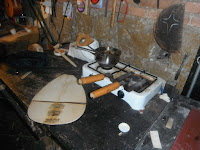 |
| Street scene, Naples |
 |
| Hand painted tambourines |
Rocella Ionica, Calabria, Italy
March 2016
The four of us rented a car from a company at the Reggio Calabria airport for only 7€ per day. We took it for 10 days and made a trip to Naples (Napoli). From our location here in Roccella Ionica it's a 500km drive on scenic highways through the mountains of southern Italy and along the Tyrrhenian Sea, with spectacular views all along the way.
We stayed in Herculaneum, a town at the base of Mt. Vesuvius and about 20km away from Naples. There are two now famous towns that were buried by ash when Vesuvius erupted in 79 A.D.: Pompeii and Herculaneum. A short walk from our B&B brought us to the excavation in Herculaneum.
 |
| The chariots just went by. |
 |
| Original wall painting, colours too |
It was buried in 60 feet of ash, which has turned to rock, and was discovered slowly as a result of wells and tunnels dug into the town. The first excavation took place in the 1700's. Seventy five percent of the ancient city is still buried under the present day town of Ercolano.
 |
| See the modern city above Ercolano? |
 |
| Roadside restaurant, help yourself! |
 |
| This is what is still under Ercolano. |
What sets it apart from Pompeii is that, while the actual site is smaller, it is much better preserved. Three story buildings still stand and in some cases the original wood lintels in the doors and windows exist, now charred in appearance due to the extreme heat of the eruption and ensuing pyroclastic surge of gas and ash. There are grim reminders of the catastrophe in the form of fossilized skeletons of victims that were instantly killed by the fury of the volcano. When you stand in the present-day town and look over at the distant Vesuvius, it is hard to imagine the violence of the eruption that erased the towns between it and the sea.
 |
| Branko made me take this. |
 |
| Check out the floor. |
That was on the first day when we arrived. The next saw us take the circumvesuvio train to Naples, which is only a 20-30 minute ride. The station is near the historical centre of town and we hoofed directly to it. Naples is one of the bigger cities in Italy, and like most of them, has wonderful sights. We love to traipse through the various neighbourhoods, climb through narrow alleyways and up to vantage points to get the best views, and to chat with folks and see how they live.
 |
| Duomo ceiling, Naples |
 |
| Gateway to old Naples |
 |
| The famous steps |
Naples does not disappoint. There are the requisite beautiful cathedrals, historical buildings, castles, forts, and museums, but what I liked best was the view from the hilltop at the north end of the city. An arduous set of stairs lead up to the castle, now a museum, atop the hill. From there you see Naples lying at the top of the Bay of Naples, the sea to your right and the sleeping volcano brooding away in the distance. The descent takes you down to the port and the massive four-cornered castle that once guarded the port.
We spent two days walking all over Naples and each night we all came back tired and grimy to our digs - called Vesuvius Smiling - to take a shower (pups too cause they were filthy walking so close to the ground) and rest. I was also on a mission while in Naples to have my guitar (thanks Gayle and Jeff) refretted because I actually wore ruts into the top three from playing so much and using a capo.
 |
| Branko, his fixed guitar and new friends. |
On Via San Sebastione there are several excellent music stores and one special luther's shop called Anema e Corde on a side street called Port'Alba. They carefully repaired the frets for me on the same day and gave me a tour of the shop. If I had 3000€ I would have bought one of their guitars even though they specialize in Italian mandolins and restorations.
On the drive back we took a route through the rugged mountains of Calabria to see the spectacular scenery and the mountain towns. Before there were cars and roads, these places were remote and often if you were born in one of those villages, you likely never left it. No problem for us, though, except for the poor condition of some the roads and the torturous, twisting turns.
 |
| Selfie |
 |
| What next they ask? |
We had the car for a few more days, so we made a trip back to the Tyrrhenina Sea to visit the town of Tropea along with new friends Tracy and Mike from Rio Luna. I realized when we arrived to this beautiful sea-side town that I was starting to take for granted all the beautiful things to see in Italy. Here we were strolling through a picturesque and popular resort town with a beautiful beach set in the rolling hillside and I wasn't overly impressed.
 |
| Caulonia Superior |
 |
| Back road to Stilo |
 |
| Tropea, from the sandcastle |
 |
| Tropea again |
 |
| Festa in Caulonia |
 |
| Winding roads |
When we eventually leave the Med, we will pass through the Messina straights and visit more of the Tyrrhenian coast of Italy. I will promise to be more impressed.
Branko





































